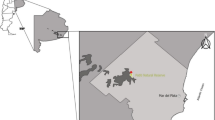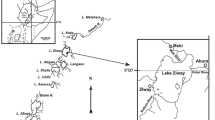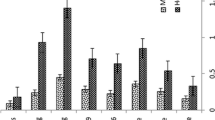Abstract
In the present study, we investigated the concentrations and distribution of organochlorine pesticides (OCs) and polychlorinated biphenyls (PCBs) in intestine, liver, and muscle samples of 11 common buzzards (Buteo buteo) from Sicily used as bioindicator for monitoring pollution in environment. All samples of common buzzards were collected at the “Recovery Center of Wild Fauna” of Palermo, through the Zooprophilactic Institute. Quantitative determination of OCs and PCBs in the samples examined has been carried out using HRGC-ECD and GC-MS. The results obtained show the presence of concentrations of ∑DDT and ∑PCB in almost all samples. Regarding ∑DDT (4,4′-DDE, 2,4′-DDD, 4,4′-DDD, 2,4′-DDT, and 4,4′-DDT), the highest concentrations were found in intestine (0.411 ± 0.050 μg/g) followed by muscle (0.130 ± 0.017 μg/g) and liver samples (0.109 ± 0.014 μg/g). As regards the ∑PCB congeners (PCB-28, PCB-52, PCB-95, PCB-99, PCB-101, PCB-110, PCB-138, PCB-146, PCB-149, PCB-151, PCB-153, PCB-170, PCB-177, PCB-180, PCB-183, and PCB-187), the highest concentrations were found in intestine (1.686 ± 0.144 μg/g) followed by liver (1.064 ± 0.162 μg/g) and muscle samples (0.797 ± 0.078 μg/g). Our data deserve particular attention not only for their significance but especially because they were recorded in Sicily, a region with a very low risk of environmental pollution due to the shortage of industries.
Similar content being viewed by others
References
Ahlborg, U. G., Becking, G. C., Birnbaum, L. S., Brouwer, A., Derks, H. J. G. M., & Feeley, M. (1994). Toxic equivalency factors for dioxin-like PCBs. Chemosphere, 28, 1049–1067.
Battaglia, A., Ghidini, S., Campanini, G., & Spaggiari, R. (2005). Heavy metal contamination in little owl (Athene noctua) and common buzzard (Buteo buteo) from northern Italy. Ecotoxicology and Environmental Safety, 60, 61–66.
Blus, L. J. (1995). Organochlorine pesticides. In D. J. Hoffman, B. A. Rattner, G. A. Burton Jr. & J. Cairns Jr. (Eds.), Handbook of Ecotoxicology (pp. 275–300, 775 pp.). Boca Raton, Florida: Lewis Publisher/CRC Press, Inc.
Brown, J. F., Lawton, R. W., Ross, M. R., & Feingold, J. (1999). Assessing the human health effect PCBs. Chemosphere, 62, 278–285.
Burger, J. (1993). Metals in avian feathers: Bioindicators of environmental pollution. Reviews in Environmental Toxicology, 5, 203–311.
Burger, J., & Gochfeld, M. (1995). Biomonitoring of heavy metals in the Pacific basin using avian feathers. Environmental Toxicology and Chemistry, 14(7), 1233–1239.
Burger, J., & Gochfeld, M. (2000). Metals in albatross feathers from Midway Atoll: Influence of species, age and nest location. Environmental Research Section A, 82, 207–221.
Di Bella, G., Licata, P., Bruzzese, A., Naccari, C., Trombetta, D., Lo Turco, V., et al. (2006). Levels and congener of plychlorinated biphenyl and organochlorine pesticides residues in bluefin tuna (Thunnus thynnus) from the Straits of Messina (Sicily, Italy). Environmental International, 32, 705–710.
Fossi, M. C., Massi, A., Lari, L., Marsili, L., Focardi, S., Leonzio, C., et al. (1995). Interspecie differences in mixed function oxidase activity in birds: Relationship between feeding habits, detoxication activities and organochlorine accumulation. Environmental Pollution, 90, 15–24.
Furness, R. W. (1993). Birds as monitors of pollutants. In R. W. Furness & J. J. P. Greenwood (Eds.), Birds as monitors of environmental change (pp. 86–102). London: Chapman & Hall.
Guruge, K. S., Watanabe, M., Tanaka, H., & Tanabe, S. (2001). Accumulation status of persistent organochlorines in albatrosses from the North Pacific and Southern Ocean. Environmental Pollution, 114, 389–398.
Hasegawa, J., Matsuda, M., Ohnishi, H., Enomoto, T., Kawano, M., & Wakimoto, T. (2007). PCBs and hydroxylated PCBs in the tissues of wild birds and fish prey from Japan. Organohalogen Compounds, 69, 1495–1498.
Hela, D. G., Konstantinou, I. K., Sakellarides, T. M., Lambropoulou, D. A., Akriotis, T., & Albanis, T. A.(2006). Persistent organochlorine contaminants in liver and fat of birds of prey from Greece. Archives of Environmental Contamination and Toxicology, 50, 603–613.
Herzke, D., Gabrielsen, G. W., Evenset, A., & Burkow, I. C. (2003). Polychorinated camphenes (toxaphenes), polybrominated diphenylethers and other halogenated organic pollutants in glaucous gull (larus hyperboreus) from Svalbard and Bjrnya (Bear Island). Environmental Pollution, 121, 293–300.
Jaspers, V. L. B., Covaci, A., Voorspoels, S., Dauwe, T., Eens, M., & Schepens, P. (2006). Brominated flame retardants and organochlorine pollutants in aquatic and terrestrial predatory birds of Belgium: Levels, patterns, tissue distribution and condition factors. Environmental Pollution, 139, 340–352.
Jaspers, V. L. B., Dirtu, A. C., Eens, M., Neels, H., & Covaci, A. (2008). Predatory birds species show different patterns of hydroxilated polychlorinated biphenyls (HO-PCBs) and polychlorinated biphenyls PCBs. Environmental Science and Technology, 42, 3465–3471.
Kannan, K., Kumar, K. S., Nakata, H., Falandysz, J., Oehme, G., & Masunaga, S. (2003). Polychlorinated biphenyls, dibenzo-p-dioxins, dibenzofurans, and p, p ′-DDE in livers of white-tailed sea eagles from Eastern Germany, 1979–1998. Environmental Science and Technology, 37, 1249–1255.
Klasson-Wehler, E., Bergman, A., Athanasiadou, M., Ludwig, J. P., Auman, H. J., Kannan, K., et al. (1998). Hydroxylated and methylsulfonyl polychlorinated biphenyl metabolites in albatrosses from Midway Atoll, North Pacific Ocean. Environmental Toxicology and Chemistry, 17, 1620–1625.
Klemens, J. A., Harper, R. G., Frick, J. A., Capparella, A. P., Richardson, H. B., & Coffey, M. J.(2000). Patterns of organochlorine pesticide contamination in neotropical migrant passerines in relation to diet and winter habitat. Chemos, 41, 1107–1113
Kumar, K. S., Kannan, K., Giesy, J. P., & Masunaga, S. (2002). Distribution and elimination of polychlorinated dibenzo-p-dioxins, dibenzofurans, biphenyls, and p, p ′-DDE in tissues of bald eagles from the Upper Peninsula of Michigan. Environmental Science and Technology, 36, 2789–2796.
Licata, P., Trombetta, D., Cristani, M., Giofrè, F., Martino, D., Calò, M., et al. (2004). Levels of “toxic” and “essential” metals in samples of bovine milk from various dairy farms in Calabria, Italy. Environmental International, 30, 1–6.
Lòpez-Lòpez, T. J., Avarez-Pineiro, M. E., Lage-Yusty, M. A., & Simal-Lozano, J. (2001). PCBs in three predatory birds from Galicia (NW Spain). Bullettin of Environmental Contamination and Toxicology, 66, 497–503.
Manosa, S., Mateo, R., Freixa, C., & Guitart, R. (2003). Persistent organochlorine contaminants in eggs of northern goshawk and Eurasian buzzard from northeastern Spain: Temporal trends to changes in the diet. Environmental Pollution, 122, 351–359.
Naert, C., van Peteghem, C., Kupper, J., Jenni, L., & Naegeli, H. (2007). Distribution of polychlorinated biphenyls and polybrominated diphenyl ethers in birds of prey from Switzerland. Chemosphere, 68, 977–987.
Norstrom, R. J., Simon, M., Moisley, J., Wakeford, B., & Weseloh, D. V. C. (2000). Geographical distribution (2000) and temporal trends (1981–2000) of brominated diphenyl ethers in Great lakes herring gull eggs. Environmental Science and Technology, 36, 4783–4789.
Olafsdottir, K., Petersen, A., Magnusdottir, E. V., Bjoornsson, T., & Johannesson, T. (2001). Persistent organochlorine levels in six prey species of the gyrfalcon Falco rusticolus in Iceland. Environmental Pollution, 112, 245–251.
Pharmeuropa (1999). The European pharmacopeia forum. Technical guide for the elaboration of monograph (3rd ed., p. 66). Strasbourg: Pharmeuropa.
Savinova, T. N., Polder, A., Gabrielsen, G. W., & Skaare, J. W. (1995). Chlorinated hydrocarbons in seabirds from the Barents Sea area. The Science of the Total Environment, 160/161, 497–504.
Tanabe, S., Senthilkumar, K., Kannan, K., & Subramanian, A. N. (1998). Accumulation features of polychlorinated biphenyls and organochlorine pesticides in resistant and migratory birds from South India. Archives of Environmental Contamination and Toxicology, 34, 387–397.
van Drooge, B., Mateo, R., Vives, I., Cardiel, I., & Guitart, R. (2008). Organochlorine residue levels in livers of birds of prey from Spain: Inter-species comparison in relation with diet and migratory patterns. Environmental Pollution, 153, 84–91.
Verreault, J., Letcher, R. J., Muir, D. C. G., & Chu, S. (2005). New organochlorine contaminants and metabolites in plasma and eggs of glaucous gulls (Larus hyperboreus) from the Norwegian Arctic. Environmental Toxicology and Chemistry, 24, 2486–2499.
Vives, I., Grimalt, J. O., Catalan, J., Rosseland, B. O., & Battarbee, R. W. (2004). Influence of altitude and age in the accumulation of organochlorine compounds in fish from high mountain lakes. Environmental Science and Technology, 38, 690–698.
Walker, C. H. (1990). Persistent pollutants in fish-eating sea birds-bioaccumulation, metabolism and effects. Aquatic Toxicology, 17, 293–324.
Wania, F., & Mackay, D. (1996). Tracking the distribution of persistent organic pollutants. Environmental Science and Toxicology, 30, 390–396.
WHO (World Health Organization) (1993) Environmental health criteria 162: Brominated diphenyl ethers. Geneva, Switzerland.
Wienburg, C. L., & Shore, R. F. (2004). Factors influencing liver PCB concentrations in sparrowhawks (Accipiter nisus), kestrels (Falco tinnunculus) and herons (Ardea cinerea) in Britain. Environmental Pollution, 132, 41–50.
Author information
Authors and Affiliations
Corresponding author
Rights and permissions
About this article
Cite this article
Licata, P., Naccari, F., Dugo, G. et al. Organochlorine pesticides and polychlorinated biphenyls in common buzzard (Buteo buteo) from Sicily (Italy). Environ Monit Assess 184, 2881–2892 (2012). https://doi.org/10.1007/s10661-011-2157-9
Received:
Accepted:
Published:
Issue Date:
DOI: https://doi.org/10.1007/s10661-011-2157-9




